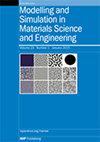界面和基体强度对单向CFRP复合材料横向抗拉强度的影响
IF 2.4
4区 材料科学
Q3 MATERIALS SCIENCE, MULTIDISCIPLINARY
Modelling and Simulation in Materials Science and Engineering
Pub Date : 2023-06-27
DOI:10.1088/1361-651X/acde93
引用次数: 0
摘要
为了说明界面和基体对单向碳纤维增强聚合物(UD-CFRP)复合材料横向力学性能的影响,提出了一种考虑界面开裂过程的UD-CFRP横向抗拉强度计算方法。基于带有裂纹界面的典型体元模型,考虑了界面裂纹对复合材料应力场的影响,采用Benzeggagh-Kenane准则模拟了界面裂纹的扩展行为。采用理论方法和随机纤维分布的有限元模型研究了单向T300/BSL914C复合材料的横向拉伸强度。理论计算结果与有限元计算结果吻合较好,给出了复合材料强度、界面强度和基体强度之间的关系。结果表明:根据界面与基体的强度比,界面可分为三种类型:最弱界面、弱界面和强界面。当界面属于弱界面或强界面时,横向抗拉强度不受界面强度的影响,并随基体强度的增加而线性增加。当界面为弱界面时,横向抗拉强度随界面强度的增加而线性增加,不受基体强度的影响。本文章由计算机程序翻译,如有差异,请以英文原文为准。
Effect of interface and matrix strength on transverse tensile strength of unidirectional CFRP composite
To illustrate the effect of interface and matrix on the transverse mechanical properties of unidirectional carbon fiber reinforced polymer (UD-CFRP) composites, a calculation method for the transverse tensile strength of UD-CFRP considering the interface cracking process was proposed. The effect of interface crack on the composite stress field was considered based on the representative volume element model with a crack interface, and the crack propagation behavior of interface was simulated by the Benzeggagh-Kenane criterion. The transverse tensile strength of unidirectional T300/BSL914C composites was studied using the theoretical method and finite element (FE) model with random fiber distribution. The theoretical results agreed well with the FE results and the relationships between composite strength, interface strength and matrix strength were provided by the theoretical method. The results show that the interface could be divided into three types according to the strength ratio of interface and matrix, including weakest interface, weak interface, and strong interface. When the interface belongs to the weakest or strong interface, the transverse tensile strength is unaffected by the interface strength and it increases linearly with the increase of matrix strength. When the interface belongs to the weak interface, the transverse tensile strength increases linearly with the increase of interface strength and it is unaffected by matrix strength.
求助全文
通过发布文献求助,成功后即可免费获取论文全文。
去求助
来源期刊
CiteScore
3.30
自引率
5.60%
发文量
96
审稿时长
1.7 months
期刊介绍:
Serving the multidisciplinary materials community, the journal aims to publish new research work that advances the understanding and prediction of material behaviour at scales from atomistic to macroscopic through modelling and simulation.
Subject coverage:
Modelling and/or simulation across materials science that emphasizes fundamental materials issues advancing the understanding and prediction of material behaviour. Interdisciplinary research that tackles challenging and complex materials problems where the governing phenomena may span different scales of materials behaviour, with an emphasis on the development of quantitative approaches to explain and predict experimental observations. Material processing that advances the fundamental materials science and engineering underpinning the connection between processing and properties. Covering all classes of materials, and mechanical, microstructural, electronic, chemical, biological, and optical properties.

 求助内容:
求助内容: 应助结果提醒方式:
应助结果提醒方式:


